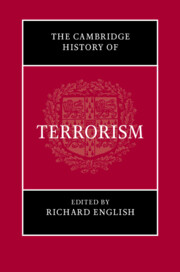Book contents
- The Cambridge History of Terrorism
- The Cambridge History of Terrorism
- Copyright page
- Contents
- Figures
- Tables
- Acknowledgements
- Contributors
- Part I Introduction
- Part II Frameworks and Definitions
- Part III Historical Case Studies in Terrorism
- 7 Terrorism in Israel/Palestine
- 8 Terrorism in the Basque Country
- 9 Terrorism in African History
- 10 The History of Terrorism in Pakistan
- 11 Political Violence in Ireland
- 12 Terrorism in the Russian Empire
- 13 Terrorism in Post-Soviet Russia
- 14 Terrorism in the Netherlands
- 15 Terrorism: An American Story
- 16 Political Violence and Terrorism in Colombia
- 17 The Paths of Terrorism in Peru
- 18 Aiqtihams (Whirlwind Attacks)
- 19 Transnational Connections
- Part IV Thematic Essays
- Part V Conclusion
- Index
- References
18 - Aiqtihams (Whirlwind Attacks)
The Rise, Fall and Phoenix-Like Resurgence of ISIS and Shiite Terrorist Groups in Iraq
from Part III - Historical Case Studies in Terrorism
Published online by Cambridge University Press: 07 May 2021
- The Cambridge History of Terrorism
- The Cambridge History of Terrorism
- Copyright page
- Contents
- Figures
- Tables
- Acknowledgements
- Contributors
- Part I Introduction
- Part II Frameworks and Definitions
- Part III Historical Case Studies in Terrorism
- 7 Terrorism in Israel/Palestine
- 8 Terrorism in the Basque Country
- 9 Terrorism in African History
- 10 The History of Terrorism in Pakistan
- 11 Political Violence in Ireland
- 12 Terrorism in the Russian Empire
- 13 Terrorism in Post-Soviet Russia
- 14 Terrorism in the Netherlands
- 15 Terrorism: An American Story
- 16 Political Violence and Terrorism in Colombia
- 17 The Paths of Terrorism in Peru
- 18 Aiqtihams (Whirlwind Attacks)
- 19 Transnational Connections
- Part IV Thematic Essays
- Part V Conclusion
- Index
- References
Summary
In the winter of 2016 I partook in a tour of the front lines facing the Dawla al Islamia, the Islamic State, in northern Iraq. Two years earlier ISIS had burst on to the world stage and conquered vast swathes of territory in a now borderless region known as ‘Syraq’. In 2014, Iraq alone suffered a third of the world’s terrorism fatalities. But not all these deaths came at the hands of ISIS or its predecessor ‘Al Qaeda in Iraq’. With Sunni ISIS garnering attention as the world’s most deadly terrorist group, less attention has been paid to the terror campaign carried out by Shiite groups that was launched, in part, as a response to the terror campaign by Sunni Al Qaeda in Iraq (AQI) and ISIS. Many observers who commented on this wave of terrorism described the spectacular rise of ISIS in 2012–14 and emergence of Iranian-backed Iraqi Shiite terrorist groups as coming ‘out of the blue’. But there was a long and rarely studied prehistory to the rise of terrorism in this land that begins with the 2003 US–British invasion of this secular, Baathist-dominated country that had previously served as ‘firewall’ against both Shiite and Sunni sectarian radicalism. An understanding of this background history and the role of 2003’s Operation Iraqi Freedom in opening the Pandora’s box of sect-based terrorism in Iraq is crucial to explaining the origins, goals, tactics and local and global impact of the terrorists operating in this land.
- Type
- Chapter
- Information
- The Cambridge History of Terrorism , pp. 453 - 476Publisher: Cambridge University PressPrint publication year: 2021

